Engaruka is situated 63 kilometers north of Mto wa Mbu, on the road to Oldoinyo Lengai and Lake Natron. The village Engaruka lies on the foot of the rift valley escarpment. Fast flowing streams from the escarpment are utilized to irrigating small plots and give the village a pleasant green look, in contrast to the surrounding plains where Maasai cattle graze side by side with herds of zebras. Birds of prey circle above the area looking for a kill, while remarkable looking secretary birds, beloved as snake killers, strut across the plains. Dust cyclones are often seen on the horizon, they are feared as ” devils fingers”, bringing bad luck when they touch people. Engaruka is one of Tanzania’s most important historic sites which displayed the advanced knowledge of irrigation technology before disappearing mysteriously. Some 500 years ago, a farming community of thousands developed an ingenious irrigation and cultivation system. The water that flowed from the rift escarpment was channeled into stone-built canals and led to stone-bench terraces. Measures were taken to prevent soil erosion and to increase the fertility of the land using the manure of stall fed cattle. For unknown reasons, the farmers left Engaruka around 1700. Now, three centuries later, the ruins still give a good impression of the highly specialized, integrated agricultural economy, very remarkable for that period of African history. Although several famous archaeologists-including Louis Leakey-have investigated the Engaruka ruins, the site is still surrounded with mysteries.
Many Questions Remain Unanswered:
The ruined city of Engaruka is situated at the foot of the Rift Valley Escarpment. Here you can see the abandoned remnants of the complicated irrigation system. The guide will help you to identify old graves, house walls, irrigation canals and terraces, and explain to you the various theories of the rise and fall of this highly specialized farming community. The ruined city abounds with colorful birds and butterflies, remnants from the German colonial times and you can visit an “Olpul”, a place where Maasai slaughter and eat their cows. A one or two hours’ visit will give you an impression of the ruined city; a chance that you simply cannot miss, when passing through Engaruka. For those with more time, tours can be offered that vary from a half day to two days.
Starting from the ruins you walk down to the green village of Engaruka. On your way you will visit several farms, where various crops are grown and explanations are given about current farming and irrigation methods in the area. Engaruka is one of the few places in East Africa where Maasai are practicing irrigation, but also other tribes have arrived into the area for farming. Your guide will give you extensive descriptions of the tribal background in the village. On your way back you can visit the market area of Engaruka, located in the shade of an African tulip tree and a huge mkuyu tree. Especially on the market days – Sunday and Thursday – a visit will be an unforgettable experience.
From the ruined city narrow footpaths wind up the Rift Valley escarpment. Guided by a Maasai warrior you will gradually climb the escarpment. From above you have a wonderful view of the ruined city and over the surrounding Maasai plains. During the walk, the guide will help you to spot many colorful birds and show you trees and plants that the Maasai use for making food and for medicines.
North of Engaruka arises the green mountain of Kerimasi. The mountain is of volcanic origin, but not as steep as several other volcanoes in the area. The climb takes three to four hours from the foot of the mountain to the summit. On your way you see Maasai cattle grazing in the pastures on the slopes and birds of prey circling over the area. From the top you have impressive views of Oldoinyo Lengai, Lake Natron, the Ngorongoro highlands and the mountains of Ketumbeine and Gelai. The descend takes two hours. You will be collected by car to return you to your camp.
For a more strenuous and adventurous hike you can after climbing Kerimasi, try to conquer Oldoinyo Lengai, “the mountain of God” in the Maasai language. On day one you climb Kerimasi mountain and descend on the North side. You camp at the foot of Oldoinyo Lengai, the only active volcano in Tanzania. In the early morning of day two, preferably when it is still dark, you start climbing the steep volcano. Four to Five hours exertion will bring you to the top, where you can even enter the crater to watch the volcanic activity. Two and a half hours descent will bring you back to the foot of the Oldoinyo Lengai for collection by car.
In Engaruka there are two campsites with modest facilities. One campsite belongs to the Lutheran church and is located close to the ruined city; the other campsite belongs to a private Maasai and is situated along the main road from Mto wa Mbu to Lake Natron. In the village fresh fruits and vegetables can be bought and a women’s group can prepare a meal on request.
At the ruined city there are still several remnants of houses and graves and the former irrigation channels and stone terraces can easily be identified. Although built without cement more than 500 years ago, more has remained from the agricultural settlement than from the stone houses built by Germans early this century. However with the disappearance of the tse tse fly in the area two decades ago, cattle graze the area in the dry season, thereby heavily impacting the ruins. If this situation continues for another ten years, the ruins may disappear for good. The local community now wants to design a by-law to prohibits all cattle from entering the ruined city. In return, the community will ask an entrance fee from visitors. The fees goes to a village development fund to be used for development purposes selected by the community, such as improving the primary school or buying medicines for the cattle. In this way the ruins can be conserved and at the same time living conditions of the local people can be improved.
The Kisangara Cultural Tourism Program is situated 62 km south-east of Moshi in the shadow of Mount Kilimanjaro and the Pare Mountains. The center is reached from Mwanga town which is located on the Dar es Salaam – Moshi/Arusha main road. Kisangara Chini village is about 12 km south of Mwanga. Small local factories nearby produce bricks, stoves, pottery and sisal fibers. In their backyards some families make local beer by using traditional brewing methods inherited from their grand parents. Every Sunday and Thursday there is a colorful market. Farmers from the surrounding villages come to sell their harvest. High on the mountain, protected by natural forests and moorland, you can find important cultural sites of the Pare people. In these forests, cultural ceremonies still take place. From the mountain tops, wide and spectacular views over the surrounding plains unfold showing the extensive Kisangara Sisal Estate. On the horizon you see the long drawn-out lakes of Jipe to the east and Nyumba ya Mungu to the west, the Taita and Kiteto hills. Mount Kilimanjaro is a stone’s throw way. From many places the impressive snow capped mountain can be seen.
At the center of this Cultural Tourism Programme is Habari ya Shamba – HASHA PROJECT, which deals with appropriate technology and farming. Here you can become involved in farming activities and learn about various technologies like solar energy, rain water harvesting etc.
This tour takes you to the carpentry workshop where you can participate in the making of various items. From there you visit a brick factory where you can see the whole process. To slake one’s thirst we finish with the brewing of local beer by squeezing sugar cane.
Lembeni Herbal Hospital is 3 km from the center. Here you have an opportunity to talk with doctors and patients. You’ll see and be told about various herbal medicines used to treat different diseases.
This hike starts from the center and takes you through the forest. Activities like visiting a tree nursery and planting trees can be included. At the top you are rewarded by spectacular views of Mount Kilimanjaro, Mount Meru, Lake Jipe and Nyumba ya Mungu dam.
The spice tour takes you through spice and herb gardens. Back at the center you will be involved in the preparation and cooking of a spiced meal. After eating, a cultural interaction with villagers and local dances follow.
Drive to the Nyumba ya Mungu – House of God – dam with its electricity power station. Fisherman migrated from Lake Victoria to settle here. They like to talk with visitors while repairing their fishing nets. Adventurous visitors can make an excursion in canoes and try to catch a fish. Walking along the shores rich with bird life is a unique experience.
Our guides are all former Secondary School Students who studied here and have been trained to fully understand the programme activities. Each guide has an identity card from the Cultural Tourism Programme. Please avoid walking with unauthorized guides.
At the center there is good accommodation and catering facilities. Self-contained cottages and camping sites suit all kind of travelers. Transport can be arranged at the center..
The profit will be used to make primary school desks. Your visit helps to improve the education of the children.
In the far south of Tanzania, bordering the countries of Malawi and Zambia, lies the fascinating Region of Mbeya. The landscape is characterized by the various relief forms created by the volcanic powers of the African Rift Valley. Several old volcanoes, some of them once exploded, lie scattered over the region, and at many places you can discover hot springs. Within a few hours you can travel from the tropical shores of Lake Malawi to mountain peaks of almost three thousand meter high. Changes in the altitude and rainfall have enabled a large variety of vegetation to grow on the volcanic soils. In the lower areas you can travel through savannas and woodlands, while on the mountain slopes you can see dense natural forests and afro-alpine moor land. Also the agricultural products change drastically. High on the mountain are vast tea estates, while near the shores of Lake Malawi farmers grow rice, sugar cane and mangoes.
The Mbeya peak (2,826 m) is the most dominant mountain of the Mbeya range and is seen rising majestically from many places around Mbeya. A strenuous climb of three hours leads to the steep peak from where you have an excellent view over the Rift Valley. On the mountain slopes grow many indigenous flowers, and you may as well spot colorful butterflies.
Thirty eight km south of Mbeya, in the direction of Tukuyu and Lake Malawi, lies the Ngosi Crater Lake in a beautiful cone mountain. A narrow footpath winds uphill through a dense tropical jungle full of bamboo and wild banana trees. Small mammals and colorful birds hide behind the thick vegetation. After a strenuous climb of about one hour, you arrive at the crater rim and your efforts are rewarded with a magnificent view on the crater lake. Strange colors and water streams in the lake make local people believe that a monster houses under the water surface. Maybe it is related to the one in Loch Ness.
Not far from Tukuyu lies the natural bridge of Kiwira. The bridge was created by the powers of a fast flowing river. Local people call this miracle ‘Daraja la Mungu’, the Bridge of God. Very nearby, and well worth a visit, are the Kijungu water falls, where the water falls several meters deep in an impressive pot hole.
With its 2,960 m altitude, Rungwe mountain is the highest peak in Southern Tanzania. This great volcano, active over the past million years, dominates the whole area around Tukuyu. It is a vast wild area, more than 100 square km of forest, upland scrub and rock terrain, completely uninhabited and visited only by an occasional walker. After a long hike to the crater rim, you can beautifully overlook the south wall of the explosion crater.
The 130 kilometers drive from Mbeya to Matema beach is among the most scenic in Tanzania. A winding road passes high mountains and vast tea estates before it descends to the tropical shores of Lake Malawi. At Matema beach the Lutheran Church has a conference center and tourist resort, where you can relax as long as you want. From Matema you can make canoe trips with fishermen over the lake to a nearby village where women are specialized in pottery, and to river-mouth where you can try to see crocodiles and hippos. It is also possible to organize hikes to the Livingstone Mountains from Matema.
Forty kilometres south-east of Mbeya, in the direction of Zambia, lies the meteorite stone of Mbozi. This rare and unusual sight is the eight largest meteorite in the world, weighing about twelve tons and at least a thousand years old. Nearby the meteorite stone, the Sisi kwa Sisi society has a large plot given by the local government to enable unemployed youth from Mbeya to start profitable agricultural projects. Tourists who want to experience a true rural African experience can stay one or more days with the members of Sisi kwa Sisi on the plot and in a nearby village.
Sisi kwa Sisi Society is a grass root organization in Mbeya, that assist young people to start income generating activities. Their main activities are in agriculture, handicrafts, and tour guiding. The guides of Sisi kwa Sisi all come from Mbeya Region. They are proud of their country and descent, and know their Region very well. They all speak reasonable English, and are experienced in organising guided tours for tourists. Transport Apart from Mbeya peak, the attractions in Mbeya Region are not on a walking distance from Mbeya town. The guides of Sisi kwa Sisi can assist you to rent a car to visit the attractions, or can escort you in local busses that bring you close to the attractions. Sometimes it is also possible to rent a bike to visit an attraction. A Cultural Tourism Programme Affiliate The Sisi kwa Sisi Society is an affiliated project to the Cultural Tourism Programme (CTP). CTP is a joint programme of the Tanzania Tourist Board and the Netherlands Development Organization SNV, that assists local men and women to organize tours in the areas where they live. CTP provides the Sisi kwa Sisi Society with advises on organizing tours, and assists them in promoting Mbeya Region as a tourist destination.

Tanzania is great to visit any time of year. Most people avoid the rainy months of April, May, and November. Some travelers like to go during the peak migration season of wildebeest, zebras and number of antelopes in Serengeti National Park, Ngorongoro Highlands and Masai Mara in Kenya. Not only that most people also like to lay on the sunshine of the Zanzibar beach lure water and white sand beaches as well as diving to the coral reefs.
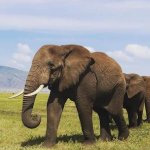
We use 5 or 7 passenger 4-wheel-drive Land Cruisers, Toyota Hiace as well as Land Rovers all with viewing roofs for the safaris. Take a note that a normal minibus or saloon can be used for transfer to and from the airport depending on the size of the group which is visit the country.
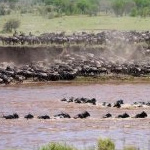
They are licensed, trained, friendly, and have years of experience in Tanzania safari! All of them speaks fluent English and others have additional languages of your mother tongue to meet your comfort and informative safari in Tanzania.
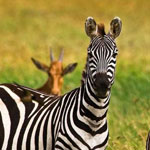
You can buy any drinks along your way to the Tanzania safari. There will be mini-markets in town and also you can have some at your hotel or lodge that you will spend an overnight there.
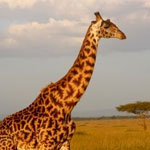
With modernized World most of the lodges and tented camps serve breakfast and dinner, typically buffet-style. European, Asian and African cuisines are served in a high standard. Due to the fact that you will be spending your afternoon doing game drive often you will have to take your lunch box with you.
If by chance the itinerary shows that you will take your hot lunch at the hotel then there is no need of packed lunch. Basically lunch at the lodge follows with a rest before proceeding with late afternoon game drive.
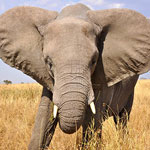
The great extraordinary animal kingdom migration is an annual migration of about 1 million wildebeest, 300000 zebras and 200000 gazelles migrating from Serengeti National Park to Ngorongoro crater and contiguous Masai Mara National Reserve searching for fresh grasses as well as water. This is a honeymoon (easy to hunt) period for the crocodile in Grumeti River and other carnivores such as lion and leopard while the migration is taking place. For more information on how the migration takes place please click here.
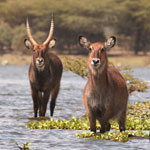
The best time to see the migration in Tanzania is January-March and June-August and in Masai Mara National Reserve in Kenya it is often best September-October. These are also the most popular times to go, so you will need to book well in advance.
You will see abundance of wildlife all year round. However it should be clear that changing of weather can affect this migration circular and a need for some two to three days in Serengeti National Park give you a wide chance of view migration properly.
Whether you are looking to explore the wildlife of the Serengeti, or begin your expedition up Mount Kilimanjaro, we have something suitable for all of you. Get in touch with us today and our team of specialists will help build your experience of a lifetime to Tanzania
Read More